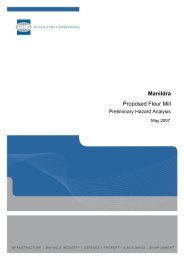Annexure F - Hydraulic Assessment.pdf - Manildra Group
Annexure F - Hydraulic Assessment.pdf - Manildra Group
Annexure F - Hydraulic Assessment.pdf - Manildra Group
You also want an ePaper? Increase the reach of your titles
YUMPU automatically turns print PDFs into web optimized ePapers that Google loves.
MANILDRA GROUP<br />
PROPOSED FLOUR MILL<br />
MANILDRA STARCHES PLANT<br />
OFF BOLONG ROAD, BOMADERRY<br />
HYDRAULIC ASSESSMENT<br />
MARCH, 2007
MANILDRA GROUP<br />
PROPOSED FLOUR MILL<br />
MANILDRA STARCHES PLANT<br />
OFF BOLONG ROAD, BOMADERRY<br />
HYDRAULIC ASSESSMENT<br />
MARCH, 2007<br />
Webb, McKeown & Associates Pty Ltd<br />
Prepared by:<br />
Level 2, 160 Clarence Street, SYDNEY 2000<br />
Telephone: (02) 9299 2855<br />
Facsimile: (02) 9262 6208 Verified by:<br />
27023:<strong>Hydraulic</strong> <strong>Assessment</strong>.doc
PROPOSED FLOUR MILL<br />
MANILDRA STARCHES PLANT<br />
OFF BOLONG ROAD, BOMADERRY<br />
HYDRAULIC ASSESSMENT<br />
TABLE OF CONTENTS<br />
PAGE<br />
1. BACKGROUND......................................................................................................... 1<br />
2. DISCUSSION ON HYDRAULIC IMPACTS AND CUMULATIVE EFFECTS .............. 2<br />
2.1. Existing Development ................................................................................ 2<br />
2.2. Proposed Development.............................................................................. 3<br />
3. CONCLUSIONS......................................................................................................... 4<br />
3.1. Conclusion from our October 2000 Report................................................. 4<br />
3.2. Proposed Development.............................................................................. 4<br />
LIST OF FIGURES<br />
Figure 1: Study Area<br />
Figure 2: Existing and Proposed Development, <strong>Manildra</strong> Starches Plant<br />
Figure 3: Aerial Photography, 1986, <strong>Manildra</strong> Starches Plant<br />
Figure 4: Aerial Photography, Circa 1999, <strong>Manildra</strong> Starches Plant<br />
Figure 5: Aerial Photography, Google, <strong>Manildra</strong> Starches Plant
<strong>Hydraulic</strong> <strong>Assessment</strong> -Proposed Flour Mill<br />
<strong>Manildra</strong> Starches Plant, off Bolong Road, Bomaderry<br />
1. BACKGROUND<br />
The subject land (Figure 1) is located on the northern bank of the Shoalhaven River adjacent to<br />
Abernathys Creek and on the southern side of Bolong Road. The townships of Nowra,<br />
Bomaderry and Terara are all in close proximity to the subject site. The site is occupied by the<br />
<strong>Manildra</strong> Starches Plant and is within the 1% annual exceedance probability (AEP) floodplain of<br />
the Shoalhaven River as defined in the Lower Shoalhaven River Flood Study (April, 1990) which<br />
was prepared by Webb, McKeown & Associates (WM) for Public Works.<br />
During major rainfall events, runoff from the Shoalhaven River catchment will enter the subject<br />
land from the south and from the Bomaderry Creek catchment to the west. Once the banks of<br />
the Shoalhaven River and Bomaderry Creek are overtopped, floodwaters will pass over the site,<br />
between the existing plant and associated buildings and towards Bolong Road. Once Bolong is<br />
overtopped, floodwaters will continue north, spreading out over the low-lying floodplain.<br />
Ultimately the floodwaters return back to the Shoalhaven River further downstream of the site.<br />
The northern floodplain is also inundated from local catchment runoff directly entering the<br />
floodplain. The main contributor is Broughton Creek.<br />
The largest floods in recent times were in August 1974, June 1975, March 1978 and April 1988.<br />
These events would all have overtopped the river bank (in parts) and caused overbank<br />
inundation. Of the four, the largest was March 1978 which reached approximately 5.0 mAHD<br />
near the site.<br />
In addition to the existing plant and associated buildings at the subject site, other development is<br />
evident on the Shoalhaven River floodplain in the vicinity. This includes a concrete batching<br />
plant (Cleary Bros), a paper mill, the Dairy Farmers complex (now closed), the 5 storage ponds<br />
opposite the paper mill, and on the opposite (southern) river bank, the Riverview Road and<br />
Terara village flood protection levees. These developments on the floodplain have resulted in a<br />
reduction in the available flow area and floodplain storage capacity during a major flood event.<br />
It is currently proposed that a flour mill be constructed within the <strong>Manildra</strong> Starches Plant off<br />
Bolong Road, comprising (refer Figure 2 for location and plan extent):<br />
• a 9 m diameter silo,<br />
• a flour mill (approximately 23 m by 11 m).<br />
This report investigates mainstream flooding resulting from Shoalhaven River or its major<br />
tributaries overtopping their banks. The impact of local catchment runoff within the site or from<br />
the nearby surrounds (such as Abernathys Creek) are not addressed. WM has not quantified<br />
the flood hazard, safety considerations or made comment on the suitability or otherwise of<br />
undertaking further development on the floodplain. These issues have been addressed by<br />
others.<br />
Webb, McKeown & Associates Pty Ltd<br />
27023:<strong>Hydraulic</strong> <strong>Assessment</strong>.doc:22 March 2007<br />
1
<strong>Hydraulic</strong> <strong>Assessment</strong> -Proposed Flour Mill<br />
<strong>Manildra</strong> Starches Plant, off Bolong Road, Bomaderry<br />
2. DISCUSSION ON HYDRAULIC IMPACTS AND CUMULATIVE<br />
EFFECTS<br />
2.1. Existing Development<br />
Development at the subject site has continued progressively since at least the 1960’s. Aerial<br />
photography showing the site in 1986 (Figure 3) indicates that from at least the early 1980’s the<br />
extent of development along the immediate northern river bank has been intensive and<br />
extensive. A comparison between the available aerial photography shown on Figures 3 to 5<br />
indicates that the majority of development within the <strong>Manildra</strong> Starches Plant over that time<br />
period has been concentrated around the northern boundary of the site, near Bolong Road.<br />
Development approval for the existing plant and associated buildings within the subject site has,<br />
to date, not been subject to detailed hydraulic modelling. Previous assessments have been<br />
based upon local flood information and knowledge available at the time. (Development outside<br />
the site has required an investigation of hydraulic effects.) In consultation with the then DLWC<br />
(now DNR) and Council in 2000 (refer Report titled “Further Development within the <strong>Manildra</strong><br />
Starches Plant off Bolong Road, Bomaderry”, dated October 2000), it was agreed that the<br />
<strong>Manildra</strong> Starches Plant should be regarded as ‘existing and approved’. The hydraulic impacts<br />
and cumulative effects of any further development (within the site) should be compared to this<br />
existing state of development.<br />
The majority of the subject site now comprises an extensive built-up arrangement of plant and<br />
associated buildings which would almost completely obstruct the movement of overbank<br />
floodwaters through the site. The intensively built-up area is shown on Figures 2 and 4 and<br />
comprises approximately 60% of the subject site lying east of Abernathys Creek, south of<br />
Bolong Road and to the car park in the east. From examination of the available plans and<br />
current aerial photography (Figures 2 and 5), it is estimated that approximately 80% to 90% of<br />
the area within the intensively built-up area provides a total barrier to the movement of<br />
floodwaters from the river northwards.<br />
The only opportunity for floodwaters to pass through this built-up area is through the limited<br />
number of gaps or openings between the existing plant and associated buildings. These “gaps”<br />
or openings generally satisfy trafficability requirements within the site. The capacity of these<br />
“gaps” to convey overbank floodwaters through the site would be low due to their meandering<br />
path (see Figure 2). In addition, the existing fence along the northern site boundary fronting<br />
Bolong Road further obstructs the movement of any floodwaters able to pass from the river<br />
northwards through the site.<br />
Webb, McKeown & Associates Pty Ltd<br />
27023:<strong>Hydraulic</strong> <strong>Assessment</strong>.doc:22 March 2007<br />
2
<strong>Hydraulic</strong> <strong>Assessment</strong> -Proposed Flour Mill<br />
<strong>Manildra</strong> Starches Plant, off Bolong Road, Bomaderry<br />
2.2. Proposed Development<br />
The hydraulic impacts of any proposed development on the floodplain are typically quantified by<br />
the use of an appropriate hydraulic model. In this case, the hydraulic impacts and cumulative<br />
effects of the proposed development within the intensively built-up area of the <strong>Manildra</strong> Starches<br />
Plant are considered insignificant for the reasons detailed below.<br />
The locations of the proposed development is shown on Figure 2. The extent and density of the<br />
existing built-up area (as detailed in the previous section and shown on Figures 2, 4 and 5) is<br />
such that the remaining space available for additional development is so limited that the<br />
additional hydraulic restrictions provided by the development would be very minor. Hence it<br />
follows that it would have only a very minor adverse hydraulic impact and would only add<br />
marginally to the overall cumulative effect of the total development. For our October 2000 study<br />
it was decided in consultation with Council and the then DLWC, that provided the proposed<br />
development was within the intensively built-up area shown on Figures 2 and 4, hydraulic<br />
modelling to quantify the hydraulic impacts and cumulative effects would not be required.<br />
A qualitative assessment of each component of the proposed development is detailed below to<br />
further confirm that the hydraulic impacts and cumulative effects are insignificant.<br />
• The proposed 9 m diameter silo is to be located largely in the “shadow” of an approved<br />
10 m diameter silo (this silo has been slightly relocated to accommodate development<br />
constraints) and will therefore have only minor impacts on existing flood flow paths.<br />
• The proposed flour mill is located so as to minimise any hydraulic impacts as it is largely<br />
in the “shadow” of the existing adjoining building. However the eastern section of the<br />
building does “close off” a 7 m wide flow path. However it should be noted that there are<br />
several other flow paths through the site (refer Figure 2).<br />
Webb, McKeown & Associates Pty Ltd<br />
27023:<strong>Hydraulic</strong> <strong>Assessment</strong>.doc:22 March 2007<br />
3
<strong>Hydraulic</strong> <strong>Assessment</strong> -Proposed Flour Mill<br />
<strong>Manildra</strong> Starches Plant, off Bolong Road, Bomaderry<br />
3. CONCLUSIONS<br />
3.1. Conclusion from our October 2000 Report<br />
The following text is taken from our October 2000 report.<br />
“In consultation with Council and the DLWC, it is agreed that any future development of the<br />
<strong>Manildra</strong> Starches Plant within the intensively built-up area, as defined on Figures 2 and 4, will<br />
not require hydraulic modelling to quantify the hydraulic impacts and cumulative effects. The<br />
hydraulic impacts and cumulative effects of such developments are considered to be<br />
insignificant given the intensive development already present. As mentioned in previous<br />
sections, the only opportunity for floodwaters to pass through the intensively built-up area of the<br />
site is through the limited number of gaps or openings between the plant and associated<br />
buildings. Although these gaps or openings may be relocated to accommodate any future<br />
development, the movement of overland floodwaters will never be completely blocked, as gaps<br />
or openings similar to those which currently exist will always be maintained for trafficability<br />
requirements.<br />
Any proposed future development is not exempt from flood hazard and structural assessment.”<br />
3.2. Proposed Development<br />
For the reasons detailed above, hydraulic modelling of the proposed development has not been<br />
undertaken and the hydraulic impacts and cumulative effects of this proposal are considered to<br />
be insignificant given the intensive development already present. There is a need however, to<br />
consider (amongst other things) the flood hazard and structural assessment (with regard to<br />
velocity of floodwaters and impact by flood debris) of the proposed development. In quantifying<br />
the flood hazard, some important issues for consideration include:<br />
• damage to the plant, including as a result of flood debris or structural failure,<br />
• damage to the plant due to the possible buoyancy of equipment,<br />
• malfunction of the plant (or any services on which the plant relies for operation) as a<br />
result of inundation and the associated risk of such malfunction to other users of the<br />
floodplain,<br />
• access and evacuation of workers from the site during floods.<br />
These issues need to be addressed at the detailed design stage and submitted as part of the<br />
Construction Certificate.<br />
Webb, McKeown & Associates Pty Ltd<br />
27023:<strong>Hydraulic</strong> <strong>Assessment</strong>.doc:22 March 2007<br />
4
FIGURES
















